The East Broad Top Railroad
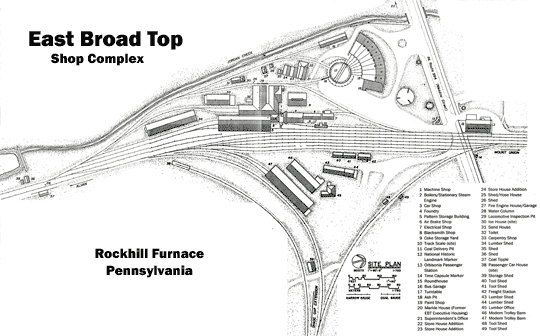
A map of the East Broad Top shop complex located at Rockhill Furnace, Pennsylvania, USA.
 Introduction Introduction
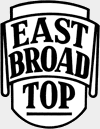 East Broad Top, the railroad where time stands still. It has been 30 years since I last visited the East Broad Top and it's still the same now as it was then. Now don't get me wrong, the aim is to preserve historic locomotives, cars, and structures, but one could reasonably expect the tracks might reach past Colgate Grove to Mount Union in thirty years. Perhaps the problem lies with the railroad's location, hence insufficient visitors to pay for a track extension to Mount Union. Either way, track to Mount Union or not, this narrow gauge piece of history deserves your support. Take a trip to the hills of Pennsylvania, you'll be amazed at what you find in Rockhill Furnace. East Broad Top, the railroad where time stands still. It has been 30 years since I last visited the East Broad Top and it's still the same now as it was then. Now don't get me wrong, the aim is to preserve historic locomotives, cars, and structures, but one could reasonably expect the tracks might reach past Colgate Grove to Mount Union in thirty years. Perhaps the problem lies with the railroad's location, hence insufficient visitors to pay for a track extension to Mount Union. Either way, track to Mount Union or not, this narrow gauge piece of history deserves your support. Take a trip to the hills of Pennsylvania, you'll be amazed at what you find in Rockhill Furnace.
 East Broad Top Railroad History East Broad Top Railroad History
The East Broad Top Railroad and Coal Co. (EBT) was chartered 16 Apr 1856, to mine and transport coal from the Broad Top coal field. Financial difficulties delayed construction of the railroad until a group of businessmen from eastern Pennsylvania revived the EBT charter on 3 Jul 1871. The same men organized the Rockhill Iron and Coal Co. (RIC) in 1872 and chose Orbisonia, formerly a center of iron production in the Juniata Valley, as the site of a new twin iron furnace. In September 1872 construction of the EBT started in Mount Union, where freight and passengers from the three foot narrow-gauge EBT could be transferred to the standard-gauge Pennsylvania Railroad. Tracks reached the new town of Rockhill Furnace in August 1873, and climbed Sideling and Wrays Hills to reach the RIC company coal mining town of Robertsdale in September 1874. Starting in that year the EBT carried coal mined at Robertsdale to Rockhill Furnace, where it was converted to coke to fuel the blast furnaces, which produced pig iron until they were finally blown out in 1908.
At Rockhill Furnace the EBT built an extensive shop complex and roundhouse. The steam-powered, belt-driven shops made the railroad almost completely self-sufficient, supplying castings, forgings, and machined parts for the railroad, the mines, and outside customers. The EBT also used its shops to build and maintain its own rolling stock. A modernization program in the early 1900s included the purchase of new Baldwin 2-8-2 Mikado locomotives and the installation of heavier track and stronger bridges. Pure quartzite ganister rock, used by the refractory brick plants in Mount Union, became an additional source of traffic for the EBT. In 1925 installation of a new coal-cleaning plant at Mount Union increased coal sales. Coal transported on the EBT peaked in 1926, when the railroad handled a total of 25,725,546 ton-miles of coal traffic. That year coal constituted 80 percent of all freight traffic, rock made up 14 percent of the freight carried by the EBT, forest products another 5 percent, and miscellaneous freight the remaining 1 percent. In 1933 the railroad adapted its overhead transfer crane in Mount Union to put narrow-gauge wheel-and-axle trucks under standard-gauge cars, allowing the EBT to move standard-gauge railroad cars over its narrow-gauge tracks.
After World War 11 the EBT's heavy reliance on coal traffic placed it in a precarious financial position as Broad Top coal mines became increasingly unprofitable. The railroad's passenger service was cut back, then eliminated entirely on 15 Aug 1954. The EBT's last mainline freight train ran on 3 Apr 1956, shortly after the last of the Mount Union brick plants converted from coal to natural gas. All common-carrier freight operations ceased officially on 14 Apr 1956.
On 1 May 1956, the Kovalchick Salvage Company purchased all assets of the EBT and its parent coal company. In 1960 EBT owner Nick Kovalchick restored tourist operation on part of the EBT for the celebration of Orbisonia's bicentennial. A five-mile segment of the EBT mainline and four of its steam locomotives have remained in operation ever since. The EBT was declared a US National Historic Landmark in 1964, and it remains the only operating narrow-gauge railroad east of the Rocky Mountains - Friends of the East Broad Top.
 East Broad Top Trackage East Broad Top Trackage
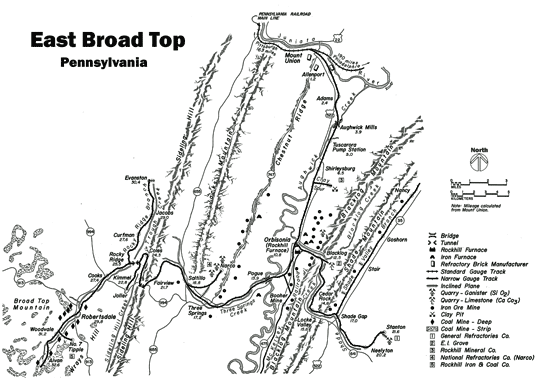
A map of the East Broad Top showing its trackage in Pennsylvania, USA.
The mainline of the East Broad Top Railroad (EBT) runs approximately 31 miles from Mount Union, through Shirleysburg, Rockhill Furnace (Orbisonia), Three Springs, Saltillo, Coles, Rocky Ridge, and Cooks, to Robertsdale, the railroad's southern operating terminus on Broad Top Mountain. The mainline was extended to Woodvale in 1891 and to Alvan in 1916 as new coal mines were opened by the Rockhill Iron and Coal Company (RIC), the EBT's parent company. Tracks along the entire mainline from Mount Union to Alvin still exist, together with most yard and service tracks, within the boundaries of the East Broad Top Railroad National Historic Landmark.
While the bulk of the EBT's traffic originated at the mines in Robertsdale and Woodvale, various branches and feeder lines were built to reach other sources of traffic. These branches are shown on the map.
The Shade Gap branch extended a RIC tramway from iron mines in the Blacklog valley to Shade Gap in 1884, and to Neelyton in 1909. A spur to a ganister quarry loading point in Stanton was constructed in 1919. Track on this branch was removed in stages: the quarry spur in 1940, the track to Neelyton in 1943, the track to Shade Gap in 1948, and the surviving spur to Blacklog in 1956.
The Shade Valley branch at one time ran northeast from Shade Gap to reach several RIC iron ore mines. Track was extended to Stair in 1886, to Goshorn in 1888, and to Nancy in 1890. This branch was torn up in 1905.
The Booher mine branch extended slightly more than two miles from the EBT mainline to serve an iron mine. It was constructed in 1891 and dismantled in 1912. In 1922-1928 part of this right-of-way was used for a logging railroad operated by the McKelvey brothers, this railroad connected to the EBT at Rockhill Furnace.
The Rocky Ridge branch was constructed to reach a non-RIC coal mine at Jacobs in 1905, it was extended to Evanston in 1917. Train service ended in 1936, and track was removed in 1940.
The No. 7 and No. 8 branch was a short spur to two RIC coal mines that opened in 1915. Mining here ceased during World War 11, after which the track was removed.
The Coles Valley branch served a non-RIC coal mine at Jolley. It was built in 1916, train service ended and tracks were removed in 1948.
The Shirleysburg clay spur extended from Colgate Grove to the base of an incline from a fire-clay quarry on Sandy Ridge. Constructed in 1918, this spur was removed between 1927 and 1930. The wye track now used to turn the EBT's trains at Colgate Grove was built on part of this right-of-way in 1961.
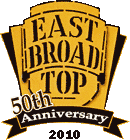 The NARCO branch was built in 1942 to provide direct service to a ganister quarry that supplied rock to one of the Mount Union brick plants. It was removed in 1956. The NARCO branch was built in 1942 to provide direct service to a ganister quarry that supplied rock to one of the Mount Union brick plants. It was removed in 1956.
At present train operations are limited to tracks within the Rockhill Furnace yard and a refurbished five-mile segment of the railroad's mainline north of the Orbisonia passenger station. Non-operating sections of the EBT's mainline in Mount Union, Aughwick Mills, Three Springs, Saltillo, and Robertsdale are readily visible from nearby public roads and highways - Friends of the East Broad Top.
 East Broad Top Steel Hoppers East Broad Top Steel Hoppers

Coal represented more than 90 percent of the EBT's traffic volume. In 1913-1914, the EBT purchased its first all-steel coal hopper cars from the Pressed Steel Car Company of Pittsburgh, Pennsylvania. These 40 two-bay hoppers had a capacity of 60,000 pounds, and were essentially a scaled-down version of a standard gauge car. The EBT was not satisfied with the capacity of the cars, however, and embarked upon a car reconstruction program. Between 1927 and 1936, the Car Shop rebuilt the PSCCo. two-bay cars into a three-bay configuration that raised the capacity to 70,000 pounds. Later the EBT constructed their own 70,000 pound steel hoppers, and boosted their capacity to 80,000 pounds by adding a 14 inch high steel band around the top edge of the car. All told, the EBT purchased or built 288 steel hopper cars, the only fleet of such cars ever built for narrow gauge service. Utilization of these cars enabled the EBT to move a greater volume of coal per freight train, and increased revenue by bettering the throughput capacity of the railroad and the coal preparation plant.
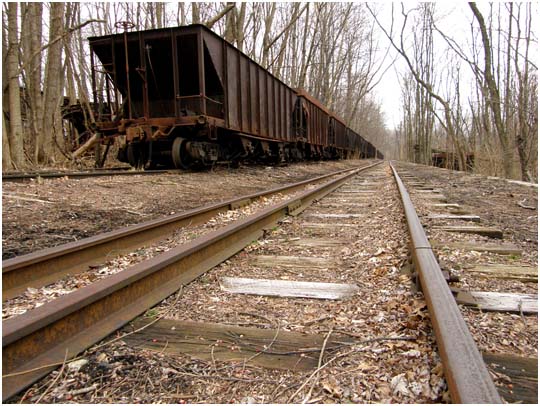
Rusting East Broad Top coal Hoppers abandoned at Mount Union - 2008 Paul Ewbank.
 News Articles News Articles
11 August 2010 - East Broad Top Railroad to be Part of 2010 Railfest
4 Oct 2010 - Railfest Loses Luster Without Excursion
 Bibliography Bibliography
Kyper, Frank
A Ramble Into the Past on the East Broad Top Railroad
East Broad Top Railroad and Coal Company Rockhill Furnace Pennsylvania USA
1971
Stapled
5 3/4 x 8 3/4 inches - 14.5 x 22.5 centimetres
63 pages 74 photos 0 drawings 1 map
US$5.00
The official souvenir booklet of the East Broad Top Railroad.
Rainey, R. Lee and Kyper, Frank
East Broad Top
Golden West Books San Marino California USA
1982
Hardcover
8 3/4 x 11 1/2 inches - 22 x 29 centimetres
258 pages ? photos ? drawings ? maps
US$49.95
This is the only source to authoritatively document the railroad from the discovery of coal in the region. The only negative is that it has negligible coverage of the railroad since the 1960's, though this era is well documented elsewhere.
Ferrell, Mallory Hope
Colorful East Broad Top
Heimburger House Publishing Company
1995
Softcover
8.4 x 10.9 inches - 21.5 x 27.5 centimetres
84 pages ? photos ? drawings ? maps
US$26.95
The book depicts this unique 3 foot gauge coal hauler in the '40s and '50s. For 83 years, the EBT connected a remote region of south central Pennsylvania with the outside world. The book contains vivid color photographs, though it contains little text on the railroad. An excellent photographic reference.
Grenard, Ross and Kramer, Frederick A.
East Broad Top to the Mines and Back
Carstens Publications Inc. PO Box 700 Newton New Jersey USA 07860
1980
Stapled
11 x 8.5 inches - 28 x 21.5 centimetres
81 pages 147 photos 0 drawings 3 maps
US$10.00
This book is a black and white photograph pictorial of the line ordered geographically. The captions are enlightening but there is little to the accompanying text. It contains many pictures not available elsewhere.
 Associated Web Sites Associated Web Sites
East Broad Top Railroad
Friends of the East Broad Top
The East Broad Top Railroad Homepage
East Broad Top Pictorial
The Last Coal Road
East Broad Top Mikados
Yahoo Group EBT
Large Scale Brass Models
Rockhill Trolly Museum
|